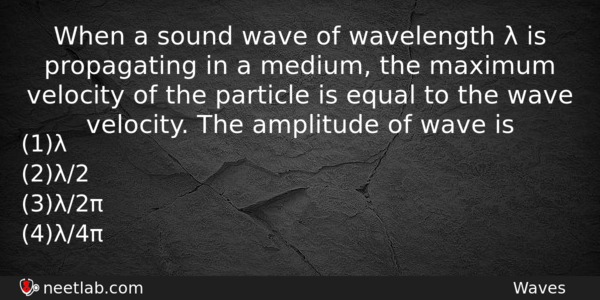| ⇦ | 
| ⇨ |
When a sound wave of wavelength λ is propagating in a medium, the maximum velocity of the particle is equal to the wave velocity. The amplitude of wave is
Options
(a) λ
(b) λ/2
(c) λ/2π
(d) λ/4π
Correct Answer:
λ/2π
Explanation:
Maximum particle velocity (vₚ)ₘₐₓ = aω
where a is the amplitude of the wave and ω is the angular frequency
Wave velocity, v = λʋ
where λ is the wavelength of a wave and ʋ is a frequency of a wave.
Given : vₚ = v .·. aω = λʋ or a × 2πʋ = λʋ or a = λ/2π
Related Questions: - Copper and carbon wires are connected in series and the combined resistor is kept
- The displacement ‘x’ (in meter) of a particle of mass ‘m’ (in kg) moving in one
- A simple pendulum performs simple harmonic motion about x = 0 with an amplitude
- The input resistance of a silicon transistor is 100 W. Base current is changed
- A body is rolling down an inclined plane.If KE of rotation is 40% of KE in a translatory
Topics: Waves
(80)
Subject: Physics
(2479)
Important MCQs Based on Medical Entrance Examinations To Improve Your NEET Score
- Copper and carbon wires are connected in series and the combined resistor is kept
- The displacement ‘x’ (in meter) of a particle of mass ‘m’ (in kg) moving in one
- A simple pendulum performs simple harmonic motion about x = 0 with an amplitude
- The input resistance of a silicon transistor is 100 W. Base current is changed
- A body is rolling down an inclined plane.If KE of rotation is 40% of KE in a translatory
Topics: Waves (80)
Subject: Physics (2479)
Important MCQs Based on Medical Entrance Examinations To Improve Your NEET Score
18000+ students are using NEETLab to improve their score. What about you?
Solve Previous Year MCQs, Mock Tests, Topicwise Practice Tests, Identify Weak Topics, Formula Flash cards and much more is available in NEETLab Android App to improve your NEET score.
Share this page with your friends

Leave a Reply